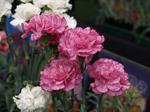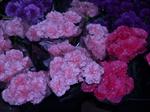 GROW BETTER CARNATIONS
GROW BETTER CARNATIONS
- As a Cut Flower
- In a Garden
- Anywhere
A course for anyone with a passion for Dianthus and Carnations
A serious course equally valuable to the home enthusiast or the commercial cut flower grower. You learn about growing quality carnations (planting, watering, pest & disease control, fertilizing), different ways of growing them (e.g. as row crops in soil, in hydroponics, in a greenhouse); and harvesting, post-harvest treatments, and quality control.
Lesson Structure
There are 9 lessons in this course:
-
Introduction
-
Review of the system of plant identification
-
Physiology
-
Information sources
-
Culture
-
Planting
-
staking
-
mulching
-
watering
-
feeding
-
pruning, etc.
-
Propagation
-
Methods of propagating this group of plants
-
Propagation of selected varieties
-
Hydroponics
-
Pest and Disease
-
Irrigation
-
Greenhouse Management
-
Harvest, Post Harvest and Quality

What are Carnations?
The name carnation is given to certain cultivars from the genus "Dianthus". Carnation is not a precise term; and may occasionally be applied to any of the Dianthus; although it is more commonly applied to larger flowered cultivars. The common name "Pink" is more often applied to smaller flowered cultivars; even those that are not pink in colour.
This course is particularly relevant to cut flower carnations; but is certainly also relevant to all other types of "Dianthus" as well.
There are a range of opportunities for developing business ventures with Dianthus and Carnations; including:
- Cut Flower Production
- Breeding New Varieties
- Seed Production
- Producing containerised plants for selling in nurseries and planting in gardens
- Herbs - growing them for oils production; medicinal, culinary or craft usess
How are Carnations Used?
Carnations are grown as both garden plants; and as commercial crops.
As a commercial crop, they are mostly cultivated for cut flowers; but are also grown for perfumery.
Perfume is extracted from carnations in southern France to produce a product called “Carnation Absolute”. This has a “floral spicy scent and clove nuance” It is used often in some of the classic fragrances in the perfumery industry; and is particularly effective when combined with rose oil.
Growing Carnations as Cut Flowers
Carnations may be grown in a way that attempts to produce single large flowers on single stems; or alternatively to produce multiple smaller flowers branching off a stem.
Standard Carnations have the side buds removed, to produce a long stem with one terminal flower. Most standards grown are bred from an American cultivar called "William Sim"
Spray Carnations are not disbudded. They are grown with many flowers branching from a stem, and are sold as a bunch.
